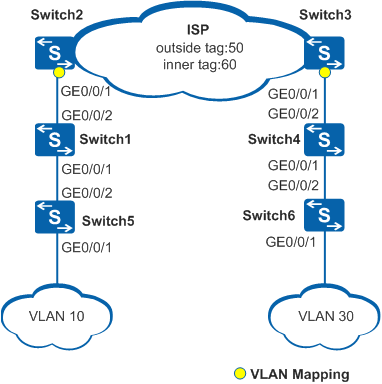Example for Configuring VLAN ID-based 2 to 2 VLAN Mapping
Networking Requirements
QinQ is used to send double-tagged packets, which prevents the conflict between C-VLAN IDs and S-VLAN IDs and differentiates services and users. However, the interface will discard the packets because C-VLAN IDs are different from S-VLAN IDs. To ensure communication continuity, configure 2:2 VLAN mapping on the PE and replace double C-VLAN tags with double S-VLAN tags.
In Figure 1, users send double-tagged packets to the ISP network. These packets cannot be sent successfully because the VLAN IDs are different from the S-VLAN IDs. To solve this problem, ensure that the users of the Switch5 and Switch6 can communicate.
Configuration Roadmap
The configuration roadmap is as follows:
Add switch ports connecting to users to VLAN 10 and VLAN 30.
Configure the QinQ function on Switch1 and Switch4 so that packets sent to the ISP network are double-tagged.
Configure 2:2 VLAN mapping on switches connected to the ISP network.
Procedure
- Add downlink interfaces on switches to specified VLANs.
# Configure Switch5.
<HUAWEI> system-view [HUAWEI] sysname Switch5 [Switch5] vlan 10 [Switch5-vlan10] quit [Switch5] interface gigabitethernet 0/0/1 [Switch5-GigabitEthernet0/0/1] port link-type access [Switch5-GigabitEthernet0/0/1] port default vlan 10 [Switch5-GigabitEthernet0/0/1] quit [Switch5] interface gigabitethernet 0/0/2 [Switch5-GigabitEthernet0/0/2] port link-type trunk [Switch5-GigabitEthernet0/0/2] port trunk allow-pass vlan 10
# Configure Switch6.
<HUAWEI> system-view [HUAWEI] sysname Switch6 [Switch6] vlan 30 [Switch6-vlan30] quit [Switch6] interface gigabitethernet 0/0/1 [Switch6-GigabitEthernet0/0/1] port link-type access [Switch6-GigabitEthernet0/0/1] port default vlan 30 [Switch6-GigabitEthernet0/0/1] quit [Switch6] interface gigabitethernet 0/0/2 [Switch6-GigabitEthernet0/0/2] port link-type trunk [Switch6-GigabitEthernet0/0/2] port trunk allow-pass vlan 30
- Configure the QinQ function on Switch1 and Switch4 so that packets sent to the ISP network are double-tagged.
# Configure Switch 1.
<HUAWEI> system-view [HUAWEI] sysname Switch1 [Switch1] vlan 20 [Switch1-vlan20] quit [Switch1] interface gigabitethernet 0/0/1 [Switch1-GigabitEthernet0/0/1] port link-type hybrid [Switch1-GigabitEthernet0/0/1] port hybrid untagged vlan 20 [Switch1-GigabitEthernet0/0/1] qinq vlan-translation enable [Switch1-GigabitEthernet0/0/1] port vlan-stacking vlan 10 stack-vlan 20 [Switch1-GigabitEthernet0/0/1] quit [Switch1] interface gigabitethernet 0/0/2 [Switch1-GigabitEthernet0/0/2] port link-type trunk [Switch1-GigabitEthernet0/0/2] port trunk allow-pass vlan 20 [Switch1-GigabitEthernet0/0/2] quit
# Configure Switch 4.
<HUAWEI> system-view [HUAWEI] sysname Switch4 [Switch4] vlan 40 [Switch4-vlan40] quit [Switch4] interface gigabitethernet 0/0/1 [Switch4-GigabitEthernet0/0/1] port link-type hybrid [Switch4-GigabitEthernet0/0/1] port hybrid untagged vlan 40 [Switch4-GigabitEthernet0/0/1] qinq vlan-translation enable [Switch4-GigabitEthernet0/0/1] port vlan-stacking vlan 30 stack-vlan 40 [Switch4-GigabitEthernet0/0/1] quit [Switch4] interface gigabitethernet 0/0/2 [Switch4-GigabitEthernet0/0/2] port link-type trunk [Switch4-GigabitEthernet0/0/2] port trunk allow-pass vlan 40 [Switch4-GigabitEthernet0/0/2] quit
- Configure 2:2 VLAN mapping on the switch connecting to the ISP network.
# Configure Switch2.
<HUAWEI> system-view [HUAWEI] sysname Switch2 [Switch2] interface gigabitethernet 0/0/1 [Switch2-GigabitEthernet0/0/1] port link-type hybrid [Switch2-GigabitEthernet0/0/1] port hybrid tagged vlan 50 [Switch2-GigabitEthernet0/0/1] qinq vlan-translation enable [Switch2-GigabitEthernet0/0/1] port vlan-mapping vlan 20 inner-vlan 10 map-vlan 50 map-inner-vlan 60
# Configure Switch3.
<HUAWEI> system-view [HUAWEI] sysname Switch3 [Switch3] interface gigabitethernet 0/0/1 [Switch3-GigabitEthernet0/0/1] port link-type hybrid [Switch3-GigabitEthernet0/0/1] port hybrid tagged vlan 50 [Switch3-GigabitEthernet0/0/1] qinq vlan-translation enable [Switch3-GigabitEthernet0/0/1] port vlan-mapping vlan 40 inner-vlan 30 map-vlan 50 map-inner-vlan 60
- Verify the configurations.
Verify that users connected to Switch5 and users connected to Switch6 can communicate with each other.
Configuration Files
Switch1 configuration file
# sysname Switch1 # vlan batch 20 # interface GigabitEthernet0/0/1 port link-type hybrid qinq vlan-translation enable port hybrid untagged vlan 20 port vlan-stacking vlan 10 stack-vlan 20 # interface GigabitEthernet0/0/2 port link-type trunk port trunk allow-pass vlan 20 # return
Switch2 configuration file
# sysname Switch2 # interface GigabitEthernet0/0/1 port link-type hybrid qinq vlan-translation enable port hybrid tagged vlan 50 port vlan-mapping vlan 20 inner-vlan 10 map-vlan 50 map-inner-vlan 60 # return
Switch3 configuration file
# sysname Switch3 # interface GigabitEthernet0/0/1 port link-type hybrid qinq vlan-translation enable port hybrid tagged vlan 50 port vlan-mapping vlan 40 inner-vlan 30 map-vlan 50 map-inner-vlan 60 # return
Switch4 configuration file
# sysname Switch4 # vlan batch 40 # interface GigabitEthernet0/0/1 port link-type hybrid qinq vlan-translation enable port hybrid untagged vlan 40 port vlan-stacking vlan 30 stack-vlan 40 # interface GigabitEthernet0/0/2 port link-type trunk port trunk allow-pass vlan 40 # return
Switch5 configuration file
# sysname Switch5 # vlan batch 10 # interface GigabitEthernet0/0/1 port link-type access port default vlan 10 # interface GigabitEthernet0/0/2 port link-type trunk port trunk allow-pass vlan 10 # return
Switch6 configuration file
# sysname Switch6 # vlan batch 30 # interface GigabitEthernet0/0/1 port link-type access port default vlan 30 # interface GigabitEthernet0/0/2 port link-type trunk port trunk allow-pass vlan 30 # return
